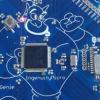Hi guys, this is not a "project" but it should be interesting to all the LED's fans.
I recently bought this set of addressable LEDs from Sparkfun:
https://www.sparkfun.../products/12877
They are very inexpensive RGB LEDs with a WS2812 inside, same idea behind Adafruit's NeoPixels ( https://learn.adafru...pixel-uberguide ) but in a regular 8mm or 5mm LED enclosure.
Apparently netduino's GPIO ports don't have enough speed to drive this directly as it needs 800Khz clock and data, so there is a tutorial (https://learn.adafru...tduino/overview) on how to re-write netduino's firmware to make it happen. I'm not a big fan of messing with firmwares, so I searched some more and found jCoder's blog ( http://jcoder.me/blo...ws2812-rgb-led/ ) with a pretty great solution for this, which is to use SPI port to send data to the LEDs.
I made some changes on jCoder's code:
- Changed the order of RGB data. Originally it was GRB because in WS2812 docs it describes this way, but these LEDs were behaving differently, so I changed to RGB and it worked.
- Created some crazy color changing code.




















